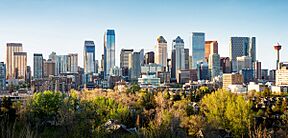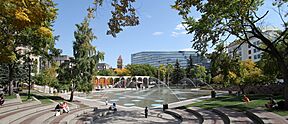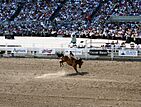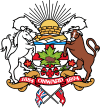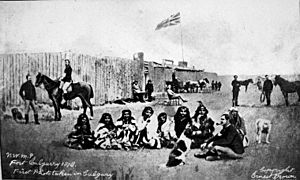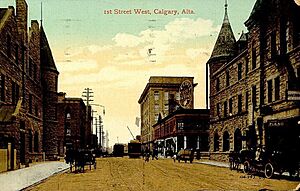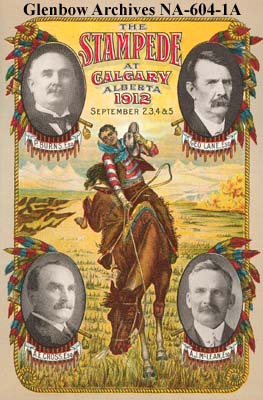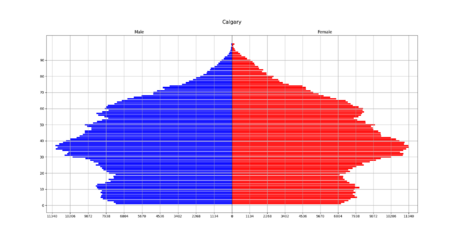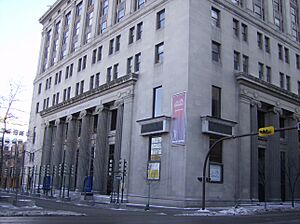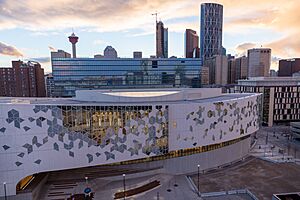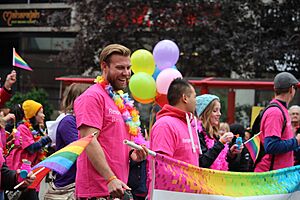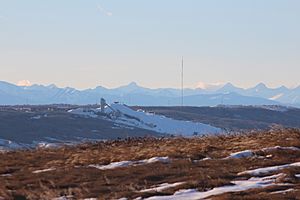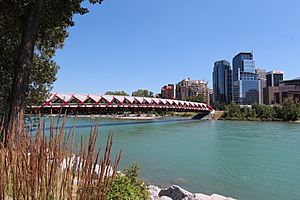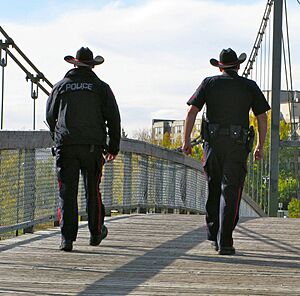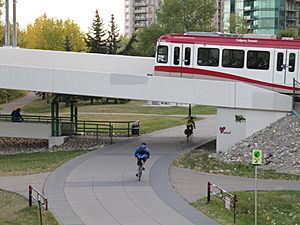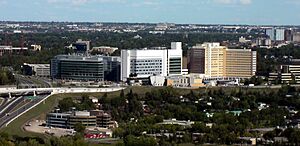Calgary facts for kids
Quick facts for kids
Calgary
|
|||||
|---|---|---|---|---|---|
| City of Calgary | |||||
|
Skyline of Downtown Calgary
Olympic Plaza
|
|||||
|
|||||
| Nicknames:
The Stampede City, Cowtown, Mohkínstsis, Wîchîspa Oyade, Guts’ists’i more...
|
|||||
| Motto(s):
Onward
|
|||||
| Country | Canada | ||||
| Province | Alberta | ||||
| Region | Calgary Metropolitan Region | ||||
| Census division | 6 | ||||
| Municipal districts | Rocky View County and Foothills County | ||||
| Founded | 1875 | ||||
| Incorporated | |||||
| • Town | November 7, 1884 | ||||
| • City | January 1, 1894 | ||||
| Named for | Calgary, Mull | ||||
| Government | |||||
| • Body | Calgary City Council | ||||
| Area
(2021)
|
|||||
| • Land | 820.62 km2 (316.84 sq mi) | ||||
| • Urban | 621.72 km2 (240.05 sq mi) | ||||
| • Metro | 5,098.68 km2 (1,968.61 sq mi) | ||||
| Elevation | 1,045 m (3,428 ft) | ||||
| Population
(2021)
|
|||||
| • City | 1,306,784 (3rd) | ||||
| • Density | 1,592.4/km2 (4,124/sq mi) | ||||
| • Urban | 1,305,550 (4th) | ||||
| • Urban density | 2,099.9/km2 (5,439/sq mi) | ||||
| • Metro | 1,481,806 (5th) | ||||
| • Metro density | 290.6/km2 (753/sq mi) | ||||
| Demonym(s) | Calgarian | ||||
| Time zone | UTC−07:00 (MST) | ||||
| • Summer (DST) | UTC−06:00 (MDT) | ||||
| FSAs |
T1Y, T2A - T3S
|
||||
| Area code(s) | 403, 587, 825, 368 | ||||
| NTS Map | 082O01 | ||||
| GNBC Code | IAKID | ||||
| GDP (Calgary CMA) | CA$102.66 billion (2020) | ||||
| GDP per capita (Calgary CMA) | CA$79,885 (2022) | ||||
Calgary (/ˈkælɡəri/) is a major city in the Canadian province of Alberta. As of 2021, it was the third-largest city in Canada. Its metropolitan area was the fifth-largest in the country.
Calgary is located where the Bow River and Elbow River meet. This is in the southwest part of Alberta. It sits between the Rocky Mountain Foothills and the Canadian Prairies. The city is about 80 kilometers (50 miles) east of the Canadian Rockies. It is also about 299 kilometers (186 miles) south of Edmonton, Alberta's capital. Calgary is roughly 240 kilometers (149 miles) north of the Canada–United States border.
Calgary's economy is strong in many areas. These include energy, finance, film, transportation, and technology. It also has manufacturing, aerospace, health, retail, and tourism. The Calgary area has the second-highest number of company head offices in Canada. In 2015, Calgary had the most millionaires per person of any major Canadian city. In 2022, it was ranked as the third most livable city in the world. It was also first in Canada and North America. In 1988, Calgary was the first Canadian city to host the Olympic Winter Games.
Contents
- How Calgary Got Its Name
- Calgary's History
- Calgary's Geography
- Calgary's People
- Calgary's Economy
- Arts and Culture in Calgary
- Fun Things to Do in Calgary
- Sports and Recreation
- Calgary's Government
- City Services
- Education in Calgary
- Media in Calgary
- Famous People from Calgary
- Calgary's International Connections
- See also
How Calgary Got Its Name
Calgary was named after Calgary Castle in Scotland. This castle is on the Isle of Mull. Colonel James Macleod of the North-West Mounted Police suggested the name. He had visited the castle often. In 1876, he suggested it for what became Fort Calgary.
The Indigenous peoples of Southern Alberta have their own names for the Calgary area. Many refer to it as "elbow." This is because of the sharp bend where the Bow River and Elbow River meet. In the Blackfoot language, it is called Mohkínstsis. This also means "elbow." In the Stoney language, it is Wîchîspa Oyade, meaning "elbow town." The Cree language name is otôskwanihk, meaning "at the elbow." In the Tsuutʼina language, it is Guts’ists’i, also meaning "elbow."
There have been efforts to bring back these Indigenous names. In 2017, the Stoney Nakoda asked to rename Calgary to Wichispa Oyade.
Calgary's History
Early Days of Calgary
People lived in the Calgary area at least 11,000 years ago. Many First Nations groups lived here. These included the Niitsitapi (Blackfoot Confederacy), Nakoda, and Tsuutʼina peoples. The Métis Nation, Region 3, also lived here.
In 1787, David Thompson was the first European to visit the area. He was a 17-year-old mapmaker. In 1873, John Glenn became the first European settler. In 1875, three priests built a small cabin by the Elbow River.
Later in 1875, the North-West Mounted Police (NWMP) set up a post here. This was to protect the area from whisky traders. Inspector Éphrem-A. Brisebois led 50 Mounties to build the fort. It was first called "Fort Brisebois." But his superiors, Colonel James Macleod and Major Acheson Irvine, disagreed. Major Irvine suggested "Calgary," a name put forward by Colonel Macleod. In 1876, it was officially named Fort Calgary.
In 1877, First Nations groups gave up their land rights in the Fort Calgary region through Treaty 7.
In 1881, the government offered land for cattle ranching. This brought more people to the area. The Canadian Pacific Railway (CPR) arrived in August 1883. It built a station, and the town center moved closer to the railway. The first newspaper, The Calgary Herald, also started in August 1883.
In 1884, residents wanted their own local government. They held a public meeting and elected a civic committee. This committee worked to get a bridge, a school, and town status for Calgary. On November 27, 1884, Calgary officially became The Town of Calgary. George Murdoch was elected as the first mayor.
Challenges and the "Sandstone City"
The years 1885 and 1886 were difficult for Calgary. There were problems with law and order. A judge, Jeremiah Travis, tried to control things strictly. He even jailed the editor of the Calgary Herald for criticizing him. The town was in chaos, with two people claiming to be mayor. The federal government eventually stepped in and removed Judge Travis.
Soon after, on November 7, 1886, a large fire destroyed much of downtown Calgary. Fourteen buildings were lost. This fire led to a new rule: all large downtown buildings had to be built with sandstone. This stone was found nearby. Because of this, Calgary became known as the "Sandstone City." Many famous buildings were built this way, like Knox Presbyterian Church (1887) and Calgary City Hall (1911).
Growth into the 1900s
Calgary continued to grow. In 1889, people started buying and building land west of Centre Street. By 1892, Calgary had grown significantly. The first federal census showed 3,876 people living there.
In 1890, construction began on the Calgary and Edmonton Railway. This railway was finished in 1891. It greatly reduced travel time between Calgary and Edmonton.
In 1892, a Smallpox outbreak occurred. Some residents blamed the local Chinese population. This led to a riot where people attacked Chinese-owned businesses. The local police did not stop the riot. The mayor called in the NWMP to restore order.
On January 1, 1894, Calgary officially became a city. It was the first city in the North-West Territories. Wesley Fletcher Orr was elected as the first mayor of the City of Calgary.
The Hudson's Bay Company (HBC) opened a sales shop in Calgary in 1884. They later built one of their large department stores here in 1913.
In 1899, a small French Catholic village called Rouleauville was formed south of Calgary. It later became part of Calgary in 1907.
The 20th Century Begins
When Alberta became a province in 1905, Edmonton was chosen as the temporary capital. Calgary hoped to be the permanent capital, but Edmonton won the vote. Calgary also tried to get the provincial university, but the University of Alberta was founded in Edmonton. However, Calgary did get the provincial Normal School in 1905 and the Provincial Institute of Technology and Art (SAIT) in 1915.
Between 1905 and 1912, Calgary grew rapidly. The city added power and water services. It also paved roads and built sidewalks. A streetcar system opened in 1909 and quickly became popular. The city's population grew from 11,967 to 43,704 between 1906 and 1911. New buildings like the Calgary City Hall and the Palliser Hotel were constructed. This period also saw the end of the "Sandstone City" era. New buildings used steel frames and terracotta, like in other big North American cities.
The Stampede City
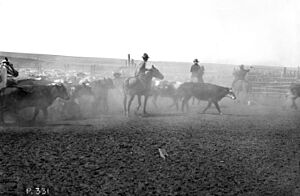
In 1908, Calgary hosted the federally funded Dominion Exhibition. The city spent money to build new pavilions and a racetrack. This event included a parade, rodeo, and horse racing. It attracted 100,000 people.
Inspired by this, an American trick roper named Guy Weadick returned to Calgary in 1912. He wanted to host a "wild west" event. With help from four local businessmen, known as the Big Four, he organized the first Calgary Stampede.
Over 100,000 people attended the six-day event in September 1912. Cowboys from across North America competed. The Stampede was a huge success. It has continued every July for over 100 years. Calgarians wear western clothes and enjoy the parade and pancake breakfasts. It is known as the "greatest outdoor show on earth."
Early Oil and Gas
While farming and railways were important, the discovery of oil changed Calgary. On May 14, 1914, the Discovery Well blew southwest of Calgary. This marked the start of the oil and gas age. Many oil companies quickly formed. People eagerly invested, but many lost money when the boom ended.
The First World War also slowed the oil craze. The city had to wait until 1947 for the Leduc No. 1 discovery. This truly made Calgary an oil and gas city. By 1967, Calgary had more millionaires than any other city in Canada. It also had more cars per person than any city in the world.
Economic Boom and Bust (1970s-1980s)
The 1970s energy crisis brought a lot of growth to Calgary. By 1981, nearly half of Calgary's workers had management or office jobs. The city's population grew from 330,575 in 1966 to 636,107 in 1986. Many tall buildings were built during this time.
However, the oil boom ended in the 1980s. This was due to falling oil prices. Unemployment increased, and the city's population decreased for the first time. Many homes faced foreclosure. The economy did not fully recover until the 1990s.
In May 1980, the Atlanta Flames hockey team moved to Calgary. They became the Calgary Flames. The team won the Stanley Cup in 1989.
Olympic Legacy
Calgary wanted to host the Winter Olympics. People were worried about the cost, like what happened with the 1976 Montreal Olympics. But the Calgary Olympic Development Association worked hard to get support. They got money from the government. On September 30, 1981, Calgary was chosen to host the 1988 Olympic Winter Games. It was the first Canadian city to host the Winter Games.
New venues were built for the Games. The Olympic Saddledome hosted ice hockey and figure skating. The Olympic Oval was built for speed skating. It was the first indoor 400-meter speed skating venue in the world. Canada Olympic Park hosted bobsled, luge, and ski jumping.
Even though Canada did not win a gold medal, the Olympics helped Calgary's economy. The city had been in a recession. The Games brought in a lot of money and created many jobs.
From 1990s to Today
Thanks to rising oil prices, Calgary's economy boomed again until 2009. The city invested in other areas like tourism and high-tech manufacturing. Over 3.1 million people visit Calgary each year for its festivals. The nearby mountain towns of Banff, Lake Louise, and Canmore are also popular. Other industries include light manufacturing, film, and transportation.
In June 2013, widespread flooding forced over 75,000 residents to leave their homes. Large parts of the city, including downtown, lost power.
Calgary's Geography
Calgary is in southern Alberta, near the Rocky Mountains. It is in the area where the Rocky Mountain Foothills meet the Canadian Prairies. Downtown Calgary is about 1,042 meters (3,419 feet) above sea level. In 2011, the city covered 825 square kilometers (319 square miles).
Two rivers and two creeks flow through the city. The Bow River is the largest. The Elbow River joins the Bow River near Fort Calgary. Nose Creek and Fish Creek also flow into the Bow River.
The City of Calgary covers 848 square kilometers (327 square miles). It has a city center surrounded by suburban areas. The city is bordered by Foothills County and Rocky View County. Nearby towns include Airdrie, Chestermere, Okotoks, and Cochrane. The Tsuu T'ina Nation Indian Reserve No. 145 is also next to Calgary.
Over the years, Calgary has added more land to allow for growth. In 2007, it annexed the former hamlet of Shepard.
Plants and Animals in Calgary
Calgary's climate allows many plants and animals to live in the city. Trees like the Rocky Mountain Douglas-fir and white spruce grow here. Deciduous trees like oak, birch, and maple are also found. Fruit trees such as crabapple and pear can grow too.
Animals in and around Calgary include white-tail deer, coyotes, moose, and rabbits. You might also see black bears, raccoons, and cougars.
Calgary's Neighbourhoods

Downtown Calgary has five main areas: Eau Claire, the Downtown West End, the Downtown Commercial Core, Chinatown, and the Downtown East Village. The commercial core has areas like Stephen Avenue and the Arts District. South of downtown is the Beltline, a very busy neighborhood. It includes communities like Connaught and Victoria Crossing. The city is working to make the Beltline even more lively.
Around the downtown are older neighborhoods like Crescent Heights, Hillhurst, Bridgeland, and Mount Royal. Further out are suburban communities like Evergreen and McKenzie Towne. Calgary has over 180 different neighborhoods.
Some of Calgary's neighborhoods used to be separate towns. These include Bowness, Montgomery, and Forest Lawn. The city grew and absorbed them.
Calgary's Climate
Calgary has a climate with warm, wet summers and cold, dry, but changing winters. Average daily temperatures range from 16.9°C (62.4°F) in July to -7.6°C (18.3°F) in January. Winters are milder than in many other parts of Alberta. This is because of warm winds called chinooks.
The highest temperature ever recorded in Calgary was 36.7°C (98.1°F) on August 10, 2018. The lowest was -45.0°C (-49.0°F) on February 4, 1893. June is the wettest month, and January is the driest. Chinooks can make it harder to grow some plants in Calgary.
Calgary's People
In 2021, Calgary's population was 1,306,784. This was a 5.5% increase from 2016. The Calgary metropolitan area had a population of 1,481,806 in 2021. This made it the fourth-largest metropolitan area in Canada.
Calgary has a high median family income of $104,530. This is partly due to the many companies and the energy sector.
In 2021, about 33.3% of Calgary's population were immigrants. This means they were born outside Canada. The top countries of origin for immigrants were the Philippines, India, and China.
Diverse Backgrounds
Pan-ethnic breakdown of Calgary from the 2021 census European (55.41%) South Asian (10.97%) Southeast Asian (8.56%) East Asian (8.49%) African (5.47%) Middle Eastern (3.55%) Indigenous (3.2%) Latin American (2.47%) Other (1.89%)
According to the 2016 Census, 60% of Calgary's population was white or European. About 4% were Indigenous. And 36.2% belonged to a visible minority group. The largest visible minority groups were South Asians, Chinese, and Filipinos.
| Panethnic group | 2021 | 2016 | 2011 | 2006 | 2001 | |||||
|---|---|---|---|---|---|---|---|---|---|---|
| Pop. | % | Pop. | % | Pop. | % | Pop. | % | Pop. | % | |
| European | 715,725 | 55.41% | 744,625 | 60.91% | 727,935 | 67.26% | 722,595 | 73.77% | 688,465 | 79.03% |
| South Asian | 141,660 | 10.97% | 115,795 | 9.47% | 81,180 | 7.5% | 56,210 | 5.74% | 36,370 | 4.17% |
| Southeast Asian | 110,610 | 8.56% | 89,260 | 7.3% | 67,880 | 6.27% | 40,325 | 4.12% | 28,605 | 3.28% |
| East Asian | 109,615 | 8.49% | 103,640 | 8.48% | 87,390 | 8.07% | 76,565 | 7.82% | 59,020 | 6.78% |
| African | 70,680 | 5.47% | 51,515 | 4.21% | 31,870 | 2.94% | 20,540 | 2.1% | 13,370 | 1.53% |
| Middle Eastern | 45,885 | 3.55% | 37,800 | 3.09% | 25,215 | 2.33% | 17,175 | 1.75% | 11,300 | 1.3% |
| Indigenous | 41,350 | 3.2% | 35,195 | 2.88% | 28,905 | 2.67% | 24,425 | 2.49% | 19,765 | 2.27% |
| Latin American | 31,855 | 2.47% | 26,265 | 2.15% | 19,870 | 1.84% | 13,120 | 1.34% | 8,525 | 0.98% |
| Other/Multiracial | 24,400 | 1.89% | 18,305 | 1.5% | 11,990 | 1.11% | 8,525 | 0.87% | 5,735 | 0.66% |
| Total responses | 1,291,770 | 98.85% | 1,222,405 | 98.64% | 1,082,230 | 98.67% | 979,485 | 99.12% | 871,140 | 99.12% |
| Total population | 1,306,784 | 100% | 1,239,220 | 100% | 1,096,833 | 100% | 988,193 | 100% | 878,866 | 100% |
| Note: Totals greater than 100% due to multiple origin responses | ||||||||||
Religions in Calgary
According to the 2021 census, about 44.5% of people in Calgary are Christian. About 38.7% reported no religion. Other religions include Islam (7.4%), Sikhism (3.8%), and Hinduism (2.6%).
Calgary's Economy
| Industry | Calgary | Alberta |
|---|---|---|
| Agriculture | 6.1% | 10.9% |
| Manufacturing | 15.8% | 15.8% |
| Trade | 15.9% | 15.8% |
| Finance | 6.4% | 5.0% |
| Health and education | 25.1% | 18.8% |
| Business services | 25.1% | 18.8% |
| Other services | 16.5% | 18.7% |
| Rate | Calgary | Alberta | Canada |
|---|---|---|---|
| Employment | 66.9% | 66.3% | 61.2% |
| Unemployment | 10.3% | 9.0% | 6.8% |
| Participation | 74.6% | 72.9% | 65.6% |
Calgary is a leader in Canada's oil and gas industry. Its economy grew much faster than the rest of Canada between 1999 and 2009. This growth led to high incomes and low unemployment.
Calgary has a strong job market. It is part of the Calgary–Edmonton Corridor, a fast-growing region. Many oil and gas companies have their main offices here. Financial services have also grown around these companies. Calgary is also a major hub for transportation and trade.
While oil and gas are still important, Calgary's economy is becoming more diverse. In 2006, oil, gas, and mining made up 12% of Calgary's economy. Many large oil and gas companies are based in Calgary.
As of November 2016, Calgary had 901,700 people in its workforce. The unemployment rate was 10.3%.
In 2013, Calgary's biggest industries were "Trade," "Professional, Scientific and Technical Services," "Health Care and Social Assistance," and "Construction."
Calgary has the second-highest number of company head offices in Canada, after Toronto. It has the most head offices per person. Some large companies with head offices in Calgary include Suncor Energy and Shaw Communications. Canadian Pacific Kansas City moved its head office to Calgary in 1996. Imperial Oil moved from Toronto in 2005.
WestJet airline has its headquarters near the Calgary International Airport.
Arts and Culture in Calgary
Calgary was named one of Canada's cultural capitals in 2012. Many people live in central neighborhoods like Kensington and Inglewood. These areas have become more popular and busy.
Stage Performances
The Southern Alberta Jubilee Auditorium is a major performing arts center. It opened in 1957 and hosts many shows. It is home to the Alberta Ballet Company and the Calgary Opera.
The city also has other performance spaces. Arts Commons is a large complex with several theaters and concert halls. Other venues include the Pumphouse Theatre and The GRAND.
Theatre
Several theater companies are based in Calgary. These include One Yellow Rabbit, Theatre Calgary, and Alberta Theatre Projects. Calgary is also the birthplace of Theatresports, which are improv games.
Music
Every three years, Calgary hosts the Honens International Piano Competition. Finalists perform with the Calgary Philharmonic Orchestra. The winner receives a large cash prize and career support.
Calgary has many marching bands, like the Calgary Round-Up Band. The Calgary Stampede Showband has won many world championships. There are also military bands and civilian pipe bands.
Calgary has a strong choral music community. Groups include the Mount Royal Choirs and the Calgary Boys' Choir.
Dance
The Alberta Ballet is Canada's third-largest dance company. It is known for its collaborations with pop artists. The Alberta Ballet is based at the Nat Christie Centre.
Other dance groups include Springboard Performance and Decidedly Jazz Danceworks.
Film and Television
Many films have been shot in Calgary and the surrounding area. These include Brokeback Mountain, Dances with Wolves, Inception, and The Revenant. Ghostbusters: Afterlife was filmed in downtown Calgary in 2019. TV shows like Fargo and The Last of Us have also been filmed here.
Visual Art
Calgary has many art galleries, especially downtown. There are also art installations in the +15 system.
Libraries
The Calgary Public Library has 21 branches. It is Canada's second-largest public library system. The new main branch, the Calgary Central Library, opened in 2018. It is located in Downtown East Village.
Museums
Calgary has several museums. The Glenbow Museum is Western Canada's largest. It has art and First Nations exhibits. Other museums include the Chinese Cultural Centre and Canada's Sports Hall of Fame. There is also The Military Museums and the National Music Centre.
Festivals

Calgary hosts many annual festivals. These include the Calgary International Film Festival and the Calgary Folk Music Festival. There is also FunnyFest Calgary Comedy Festival and GlobalFest.
Calgary's most famous event is the Calgary Stampede. It happens every July and is one of Canada's largest festivals. In 2005, over 1.2 million people attended the 10-day rodeo and exhibition.
Fun Things to Do in Calgary
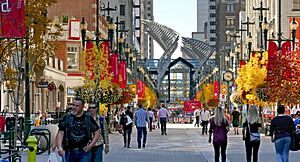
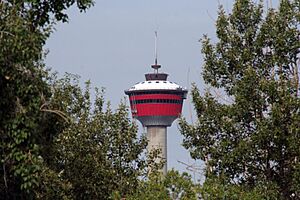
Downtown Calgary has many restaurants, shops, and cultural places. Attractions include the Calgary Tower, Wilder Institute/Calgary Zoo, and National Music Centre. You can also visit Chinatown and the Central Library. Prince's Island Park is a large urban park. The Devonian Gardens is one of the world's largest indoor gardens.
South of downtown is the Beltline. This area is known for its restaurants and nightlife. 17 Avenue SW is a popular street for entertainment. During the Calgary Flames' hockey playoffs, fans gather here. This area is known as the "Red Mile." You can easily get downtown using the CTrain. The train is free to ride downtown.
Outside downtown, you can visit Heritage Park Historical Village. It shows what life was like before 1914. It has old trains and paddle steamers. West of the city is Calaway Park, Western Canada's largest outdoor amusement park. Other attractions include Canada Olympic Park and Spruce Meadows. Calgary also has many large shopping malls.
Sports and Recreation
Calgary has about 8,000 hectares (20,000 acres) of parkland. These include Fish Creek Provincial Park, Bowness Park, and Nose Hill Park. Nose Hill Park is one of Canada's largest city parks. Calgary's oldest park, Central Memorial Park, opened in 1911. An 800-kilometer (500-mile) pathway system connects these parks and neighborhoods.
Calgary is a popular place for winter sports because it is close to the Rocky Mountains. Since hosting the 1988 Winter Olympics, it has major winter sports facilities. These include Canada Olympic Park and the Olympic Oval. These places are used for training athletes. In summer, Canada Olympic Park has mountain biking trails.
In summer, people enjoy rafting and fishing on the Bow River. Golfing is also very popular. The Century Downs Racetrack and Casino is a horse track north of the city.
Calgary's sports teams have a big rivalry with Edmonton's teams. This is known as the Battle of Alberta. The Calgary Flames (hockey) and Edmonton Oilers are rivals. So are the Calgary Stampeders (football) and Edmonton Elks.

Calgary is the hometown of the Hart wrestling family. Their "Dungeon" trained many famous professional wrestlers. These include Bret Hart and Owen Hart.
Notable sporting events held by Calgary include:
- 1972 World Figure Skating Championships
- 1995 World Junior Ice Hockey Championships
- 2006 World Figure Skating Championships
- 2021 Women's Ice Hockey World Championships
- 2023 World Junior Figure Skating Championships
| Club | League | Venue | Established | Championships |
|---|---|---|---|---|
| Calgary Stampeders | Canadian Football League | McMahon Stadium | 1945 | 8 |
| Calgary Flames | National Hockey League | Scotiabank Saddledome | 1980 | 1 |
| Calgary Roughnecks | National Lacrosse League | Scotiabank Saddledome | 2001 | 3 |
| Cavalry FC | Canadian Premier League | ATCO Field | 2018 | 1 |
| Calgary Wranglers | American Hockey League | Scotiabank Saddledome | 2022 | 0 |
| Calgary Surge | Canadian Elite Basketball League | Winsport Arena | 2023 | 0 |
| Calgary RATH | National Ringette League | Winsport Arena | 2007 | 3 |
| Calgary Wild FC | Northern Super League | McMahon Stadium | 2025 | 0 |
| Club | League | Venue | Established | Championships |
|---|---|---|---|---|
| Calgary Canucks | Alberta Junior Hockey League | Henry Viney Arena | 1971 | 9 |
| Calgary Hitmen | Western Hockey League | Scotiabank Saddledome | 1995 | 2 |
| Calgary Mavericks | Rugby Canada National Junior Championship | Calgary Rugby Park | 1998 | 1 |
| Prairie Wolf Pack | Canadian Rugby Championship | Calgary Rugby Park | 2009 | 1 |
| Calgary Rage | Western Women's Canadian Football League | Shouldice Athletic Park | 2009 | 0 |
Calgary's Government
Calgary is a major business center. Many people work in office jobs. The city has a council–manager government. This means it has a mayor and fourteen councillors. They are elected every four years. The current mayor is Jyoti Gondek.
Three school boards operate in Calgary: public, Catholic, and French-language. Trustees for these boards are elected at the same time as the City Council.
In June 2024, Calgary's first municipal political party, A Better Calgary, was formed. This happened after a new law allowed municipal political parties.
Provincial Politics
| Year | Liberal | Conservative | New Democratic | Green | |||||
|---|---|---|---|---|---|---|---|---|---|
| 2021 | 22% | 128,163 | 53% | 304,926 | 17% | 95,538 | 2% | 10,113 | |
| 2019 | 18% | 111,329 | 66% | 405,171 | 10% | 60,850 | 4% | 22,736 | |
| Year | New Democratic | United Cons. | |||
|---|---|---|---|---|---|
| 2023 | 49.3% | 272,344 | 48.3% | 266,425 | |
| 2019 | 33.9% | 188,731 | 53.0% | 294,999 | |
After the 2023 Alberta general election, Calgary is represented by 26 members of the provincial legislature. These include 14 members from the New Democratic Party (NDP) and 12 from the United Conservative Party (UCP).
Federal Politics
Calgary is divided into 10 areas for federal elections. These areas elect members to the House of Commons of Canada. Historically, most of Calgary's federal seats have been held by the main center-right party. Currently, this is the Conservative Party of Canada.
In 2015, Calgary elected its first two Liberal Members of Parliament since 1968. These were Darshan Kang and Kent Hehr. The Conservatives won back these seats in 2019. However, the Liberals won back Calgary Skyview in 2021.
The federal area of Calgary Heritage was held by former Prime Minister Stephen Harper. He was the second Prime Minister to represent a Calgary area. The first was R. B. Bennett from 1930 to 1935.
Public Safety
In 2013, Calgary's crime severity index was 60.4. This was lower than the national average. In 2015, Calgary had a record 40 homicides. In 2020, there were 38 murders and a record 112 shootings.
In 2022, Calgary's crime severity index was 75.2. This was an increase from the previous year. However, it was still lower than the national average.
Military Presence
The Canadian military has been part of Calgary since the early 1900s. Canadian Forces Base (CFB) Calgary was closed in 1998. Most units moved to CFB Edmonton. However, Calgary still has several Canadian Forces Reserve units. These include naval, army, and signal units.
The Calgary Soldiers' Memorial honors those who died serving in wars.
City Services
Getting Around Calgary
Public Transit
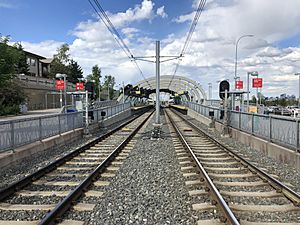
Calgary Transit provides public transportation. This includes buses, bus rapid transit (BRT), and light rail transit (LRT). Calgary's LRT system, called the CTrain, was the second in North America. It has two lines and 44 stations. The CTrain carries 270,000 passengers each weekday. About half of downtown workers use it. It is also the only rapid transit system in North America that runs on 100% wind-generated energy. In 2020, the city approved building the Green Line. This will be the third light rail line.
Airports
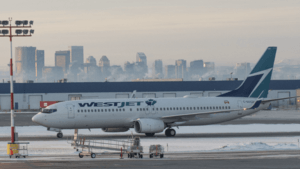
Calgary International Airport (YYC) is a major airport in Canada. It is the fourth busiest airport in Canada. In 2019, it served 18 million passengers. The airport is the main entry point to Banff National Park and the Canadian Rocky Mountain Parks. It has direct flights to cities in Canada, the United States, Europe, Central America, and Asia. Calgary/Springbank Airport handles smaller planes and is a base for firefighting aircraft.
Walking and Cycling
Calgary has the most extensive walking and cycling pathway network in North America. It spans over 1,000 kilometers (620 miles). There are also 290 kilometers (180 miles) of bike lanes on streets. The Peace Bridge connects pedestrians and cyclists to downtown.
Skywalk System
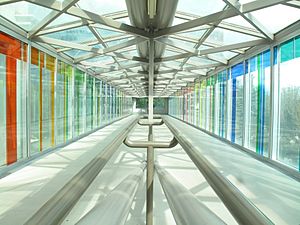
In the 1960s, Calgary started building pedestrian bridges. These bridges connect many downtown buildings. This system is called the +15. It is the world's largest elevated indoor pedestrian system. It protects people from cold winter temperatures. The bridges are usually 15 feet (4.6 meters) above ground.
Roads and Highways
Calgary is located where Highway 2 and the Trans-Canada Highway meet. This makes it an important hub for moving goods. Stoney Trail is a ring road that goes around the city. The last part of it was finished in December 2023. Highways and expressways are often called "trails." Highway 2, called Deerfoot Trail, is the main north-south route.
Rail Services
Calgary is an important hub for freight trains. This is because it is on the Canadian Pacific Kansas City mainline. There are no passenger trains that connect Calgary to other cities. However, two new rail-tour lines operate: Rocky Mountaineer and Royal Canadian Pacific.
Health Care
- Medical Centers and Hospitals
Calgary has four main hospitals for adults and one for children. These are the Alberta Children's Hospital, Foothills Medical Centre, Peter Lougheed Centre, Rockyview General Hospital, and South Health Campus. They are all managed by Alberta Health Services. Calgary also has the Tom Baker Cancer Centre.
The four largest hospitals have over 2,100 beds. They employ more than 11,500 people. The Faculty of Medicine of the University of Calgary works with Alberta Health Services. They research many health topics.
Education in Calgary
Schools for Kids
In the 2011–2012 school year, over 100,000 students were in public schools. These are run by the Calgary Board of Education. Another 43,000 students attended Catholic schools. The French-speaking community has its own school board. Calgary also has several public charter schools.
Calgary has the first high school just for Olympic athletes. It is called the National Sport School. The oldest school still open in Calgary is St. Mary's High School. There are also many private schools in the city.
Colleges and Universities
The University of Calgary (U of C) is a public research university. It is Calgary's largest university, with about 34,000 students in 2022. Mount Royal University has over 14,000 students. SAIT Polytechnic offers technical and trade education to over 14,000 students. Athabasca University provides online learning programs. Both SAIT and the University of Calgary have CTrain stations nearby.
Other public colleges in Calgary include the Alberta University of the Arts and Bow Valley College. There are also several private colleges.
Media in Calgary
Calgary's daily newspapers are the Calgary Herald and the Calgary Sun.
Calgary is the sixth-largest television market in Canada. TV stations include Global, City, CTV, and CBC.
There are many radio stations in Calgary. Some serve specific communities, like First Nations or Asian Canadians.
Famous People from Calgary
Calgary's International Connections
Calgary has partnerships with six cities around the world. These are called twinning agreements. They help with trade, culture, and education.
| City | Province/State | Country | Date |
|---|---|---|---|
| Quebec City | Quebec | Canada | 1956 |
| Jaipur | Rajasthan | India | 1973 |
| Daqing | Heilongjiang | China | 1985 |
| Naucalpan | Mexico State | Mexico | 1994 |
| Tarui | Gifu | Japan | 1996 |
| Daejeon | Daejeon | South Korea | 1996 |
| Phoenix | Arizona | US | 1997 |
Calgary is also part of the New York City Global Partners, Inc. organization.
See also
 In Spanish: Calgary para niños
In Spanish: Calgary para niños


